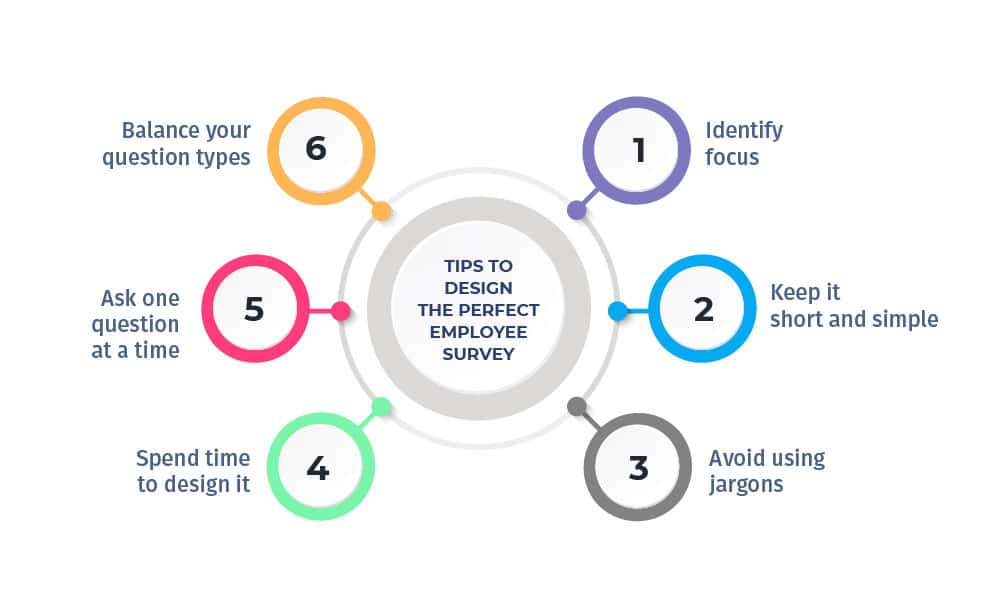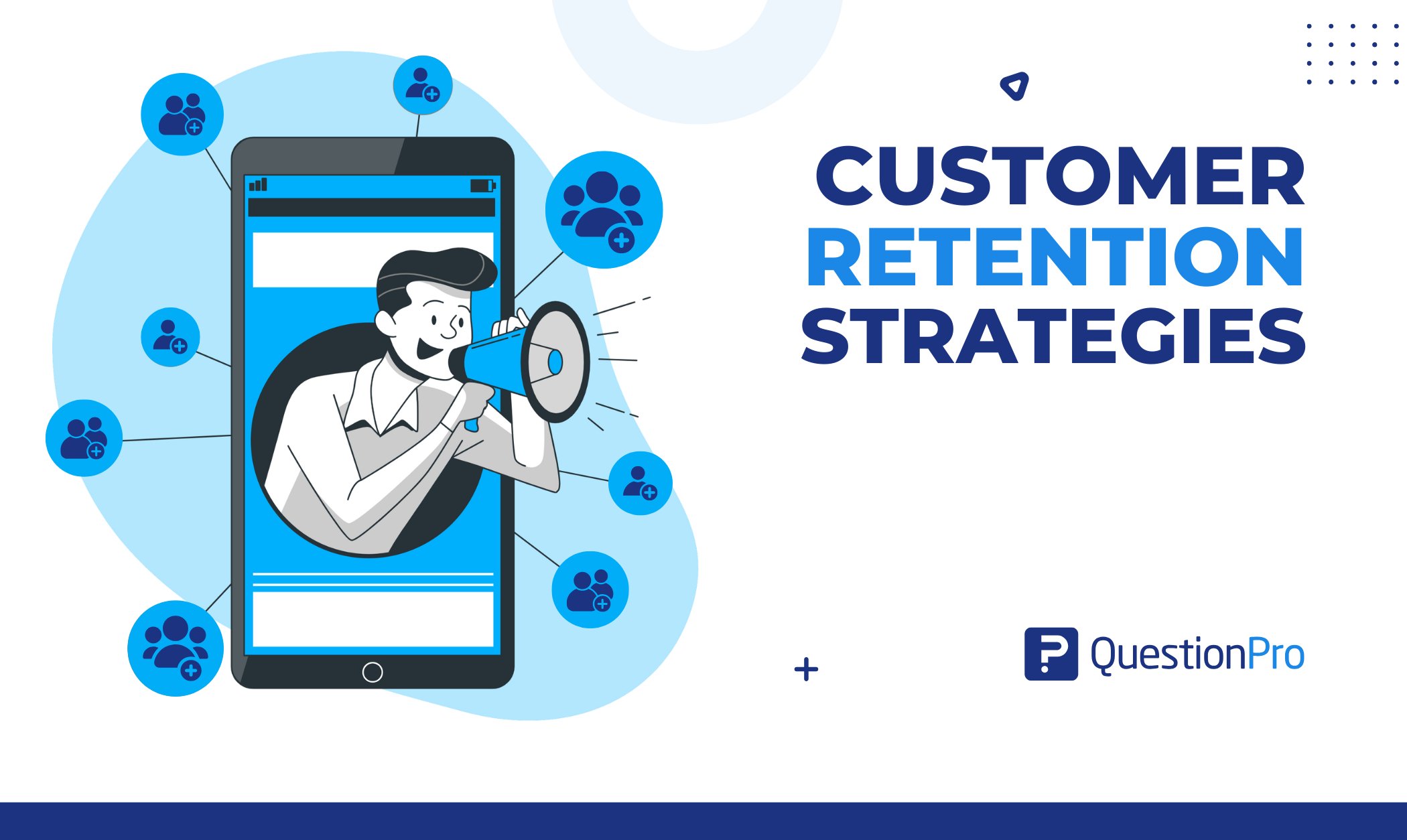
Employee survey questionnaires are integral employee feedback mediums to get perspective on factors such as work culture, direct managers, and elements that motivate or demotivate employees at the workplace.
LEARN ABOUT: Workplace Employee Experience Examples
What is an employee survey?
An employee survey is defined as a type of survey questionnaire to obtain opinions and reviews and evaluate employee mood and morale, a degree of engagement, and also monitor employee achievements. Generally, employee surveys are used by HR and Management members of an organization and are kept anonymous to motivate the workforce to comment on their good and bad experiences without any hesitation.
An employee survey can bear productive results only when designed tactfully from scratch or by using one of the 250+ survey templates, with carefully curated survey questions, and when employees are aware of the acknowledgment for their previously submitted responses by an organization’s management.
LEARN ABOUT: Testimonial Questions
Initially, in the 1920s, these surveys were introduced in the name of employee attitude surveys. After 20+ years of its initiation, the National Industrial Advisory, in the middle of 1944 and 1947, observed a more than 200% increase in organizations out of 3500 who implemented these surveys.
These days, 50-75% of organizations are determined to use employee surveys and implement changes suggested by employees to keep them engaged regularly and ultimately succeed.
5 Key considerations before conducting employee surveys
All organizations follow their own sets of procedures, rules, and objectives as per their size, structure, etc. Hence, it would be best if you managed your questions and the flow of your online questionnaire accordingly. If you are using survey templates, make sure you customize it to suit your organization.
You can use employee opinion survey questions. Those questions provide valuable insights into employee morale, enabling organizations to make informed improvements and foster an engaged workforce.
To make the most of your people surveys, make sure you consider the below 5 key points. You may look at it as a checklist of sorts before you start your surveys.
1. Define survey goals
What do you wish to achieve with your surveys? Are you looking to measure your employee engagement levels? Or improvement areas in your employee processes? Once you have that identified, you are good to go. A survey without focus is of no use to anybody. Start with identifying clear goals and then move ahead.
2. What are you trying to measure?
Set up the right indicators for what you are trying to measure. With the end goal in mind, identify what you should measure to improve. This will help in devising targeted action plans for improved results.
3. Stick to a framework
Some organizations run annual surveys, whereas some run them weekly. Whatever your needs and requirements, define the frequency accordingly. Decide on how you would run surveys, function-wise or team-wise, online or offline, etc. and design your questionnaires accordingly.
4. Use a survey tool
Using an online employee survey tool such as QuestionPro Workforce is an ideal choice. It is robust, contains a library of hundreds of survey templates, provides excellent customer support and training. The tool will do all of the heavy lifting such as scheduling questionnaires, collecting data, generating reports, etc. giving you data and ample time to focus on your people operations.
5. Keep them anonymous
Employee feedback will be genuine and candid if the employee surveys are truly anonymous. If they do not feel surveys will be anonymous, they may shy away from giving you any information. This may be due to fear of managers, backlash during appraisals, etc.
LEARN ABOUT: Performance Appraisal Survey
Use an employee survey software or platform to make sure your employee appreciation surveys are anonymous surveys and that all employee data is safe and secure.
Employee survey types with examples
There are 5 main types of employee surveys that can help business owners to boost their relationship with employees.
LEARN ABOUT: Leadership Assessment Tools
1. Employee satisfaction survey
Also known as employee morale survey, this survey is used to gather opinions that the management and HR analytic can use to build a positive environment for the employees. This can be done by understanding multiple employee perspectives, such as:
- Assessment of the human resource department
- Contentment in regards to the salary survey, Safety survey and other perks
- Overall job satisfaction
- Reasons to stay or leave the job
- Assessment of company policies
These surveys include questions that are crucial for the employee growth of an organization, such as employee loyalty, aspects of the organization that motivate them, and the scope of growth or training opportunities. Due to this, these employee surveys are usually lengthy, spanning across 60-120 survey questions.
The continuous feedback received from employees is summarized and evaluated by the management to make amends in the way they function accordingly. The employee satisfaction survey is best used to get a thorough idea of what makes an employee stay or get retained by an organization’s management.
2. Employee engagement survey
This employee engagement survey is implemented when an organization intends to monitor factors that contribute to its employee performance evaluation. An employee engagement survey is conducted with one or more purposes. The survey questions can give the management a peek into an employee’s perspective on changes in the organization, their motivation to be productive, how closely do they relate to the work culture and mission, etc. These parameters are measured using employee engagement survey:
- Employee skillset
- Employee understanding of assigned tasks
- Relationship with direct and indirect managers/supervisors
- Inter-department relationship management
- The frequency of circumstances for employees to flourish
A lot of these questions in one employee engagement survey might not provide the results that an organization would expect. It’s advised to use 30-40 survey questions from which the management can analyze results, and a plan of action can be developed accordingly.
3. Organizational culture survey
Also known as culture alignment survey, usually used in situations such as mergers and acquisitions or when there are structural changes in an organization. They’re tools used to know how well the employees understand an organization’s culture and commitment to an organization. The following parameters can be measured using organizational culture surveys:
- Organization’s mission as understood by employees
- In case of a merger, difference in the work culture of employees belonging to the two involved companies
- Contribution to team unity
- Bonding with supervisors
- Transparency about business outcome
This survey is generally used to understand how an employee is involved in the organization’s culture and growth.
4. Business process feedback survey
Employees are integral cornerstones for an organization’s success. Most of the employees who are directly interacting with customers or are involved in the research and development process of a product may have ideas and suggestions which can help an organization grow. It’s natural not to be able to execute every suggestion, but asking them for their opinion gives them a sense of belonging, which motivates them to work harder. A few reasons why to conduct a business process employee survey:
- Give an honest opinion about aspects that an organization’s management may look into.
- Employees feel appreciated as they are being involved in the business decision-making process.
- Issues that have an immediate impact on business can get highlighted as employees work closely with matters concerning customers and products/services.
5. 360° feedback survey
Feedback culture from the organization’s staff is important. But in some cases, additionally, feedback from other sources such as supervisors, senior management, clients, etc., can be gathered using a 360° feedback survey. Asking staff members of different categories, their respective colleagues, participating in a survey, and also conducting self-analysis is the key to this employee survey.
LEARN ABOUT: 360 Leadership Assessment
A 360 degree feedback survey gives multiple perspectives about an employee’s performance on the basis of which decisions about employee training, change of workload, and other factors that can further enhance an employee’s performance can be made.
These surveys consist of 4 to 7 point scale questions that give accurate insights into an employee’s performance. In some cases, open-ended questions are also used to get more information about the topic. Feedback about the entire organization and the comparison of two employees and their scores is also conducted. The specificity of this employee survey is dependent on an organization’s output requirement.
LEARN ABOUT: System Usability Scale
Analysis of the received results can be used to modify existing strategies and also to develop new ones. Critical feedback is a sign of improvement that needs to be taken constructively. It gives an organization the scope of eliminating the existing errors that offer opportunities for employees and teams to progress.
360 degree feedback surveys are instrumental in understanding the strengths and weaknesses of each staff member. Receiving feedback from multiple sources, the management can decide on personalizing training schedules for individuals who feel demotivated to work that will enhance the individual at a professional level and make him/her more suitable for an organization.
6. Employee experience survey
An employee experience survey consists of questions that help an organization measure the overall experience of an employee. It also talks about what an employee has encountered, felt, and learned in an organization.
An employee experience survey needs to have a proper blend of open-ended questions and closed-ended questions to collect employee feedback that helps relate their experience. Employee experience can be measured at different milestones in an employee’s lifecycle, like employee onboarding, training, and development, and also when an employee exits the organization.
Learn more: Salary and Compensation Survey Questions + Sample Questionnaire Template
How to ask the right questions in your employee surveys
To get the desired data from your employees, you need to ask the right questions. Asking better questions will certainly give you better answers and information.
But which questions are the right ones? How can managers know which questions are right or will give better employee responses? Every organization is unique, and what works for one organization may not work for others. You can use the below tips and guidelines to ask the right questions in your employee surveys.
- Short is right
Do not go after lengthy sentences or questions. Please keep it to the point and easy to understand.
- Do not imply or create bias
Do not ask leading questions or questions that imply something. Questions such as “What do you think about our new and stunning office space?” are a strict no-no. To get genuine feedback, stay away from such language in your questions.
LEARN ABOUT: Self-Selection Bias
- Don’t target two things in one question
Address two distinct subjects in two separate questions. Trying to get feedback on two things in one question may not only confuse the survey respondent but also make them either give incomplete information or answer only one part of the question.
- Be specific
Specificity is key to getting credible and transparent information from your online staff surveys. Being specific will help gather information to make better and informed people decisions.
Bonus tip: Try and answer your survey questions before you send them out to your employees. This will help you gauge how easy, specific, and concise your questions are.
Advantages of an employee survey
- Employee surveys will give organization opportunities to focus on aspects such as workplace culture, attracting new employees, retaining the current ones, and constantly focusing on keeping employees content.
- Efforts can be made toward improving employee productivity.
- An organization’s management can make efforts to address the various concerns employees face every day and eventually improve the entire process of solving employee complaints efficiently.
- Streamline communication with employees so that they do not shy away from sharing their issues with an organization’s management.
- Employee performance, as evaluated by team members and managers, can be evaluated continually. Every improvement tracked can be appreciated, and every reported flaw can be worked on.
- Get inputs about what can be done differently to improve business and uncover issues that may cause loss to the business according to the workforce.
Learn more: employee engagement survey examples
10 Tips for designing the perfect employee survey
1. Identify what you want to cover in a survey
Even before you finalize the survey design, it is important to think about what is the objective of deploying a survey. Identify what you want to cover in your employee survey and make sure the topic is clear at once.
2. Put questions that are necessary
When you are building a survey, to collect important insights, every question in the employee survey, should be there for a reason. It is a good idea to first plan your survey by identifying the data outcomes you need from it and then plan out what questions need to be in the survey.

3. Keep it short and simple
Employees may get irritated and less likely to complete the survey if a topic is not clear and tend to bounce back and forth. Therefore, it is good to make sure that a logical order is followed n placing the questions and to stick to a certain topic. If the survey is too lengthy, respondents might not be interested in filling out the entire survey, and survey results might get compromised. Hence, keep it short and simple.
4. Ask one question at a time
Branching questions or asking more than one question at a time can confuse employees, and they might not be able to choose correct option/options from the list of answer options provided to them. Therefore, it is advisable to ask one question at a time, to give clarity to the respondents.
5. Avoid using jargon
For employees to respond to a survey, avoid using jargon. Using a language that is easily understood by respondents will help them understand and respond to surveys better.
6. Open-ended questions or closed-ended question
This is always the tricky part, whether to ask open-ended questions or closed-ended questions? The trick here is, balance out both these options. Try and include descriptive and objective questions to balance the survey. Again question types should be carefully sorted as it defines the tone and importance of asking a question in the first place.
7. Spend time to design your survey
Now that there is clarity on what should be included in a survey, it is also important to spend some time designing a survey and make it presentable. The survey needs to create brand awareness with respondents. For this, the survey creator can use the brand language (brand logo and brand color). so respondents can correlate with it.
8. Analyze the responses after collecting
Once you’ve sent out the survey, collect all the responses, and maintain a document or excel sheet for the collected responses. This excel sheet should have all the mentioned classifications of the survey so that you have all the data in place. You need to make sure you follow this step and categorize data into Behaviour, Psychographics, and Demographics. For any researcher, it’s extremely important to have organized data so that analyzing, predicting outcomes, and writing reports become easy.
9. Put a summary report together
After collecting responses and analyzing it, share your analysis with your customers. You should have all the data gathered from surveys in a particular format by this stage. The readers should get a clear picture of your goal, i.e., what were you trying to attain from the survey? Make sure you cover questions such as do users prefer/use a particular product or service? Which product do the users prefer? Any comment?
10. Conclude your plan of action
Prepare your final action plan on the basis of your goal, responses put together, and draw conclusions. Mend your final plan and start executing the changes
Learn more: Employee Meeting Survey Questions + Sample Questionnaire Template
Ready to create a workplace culture where everyone can reach their full potential? Learn more about how to get ongoing feedback from your employees and start taking action to make a positive impact in your organization with QuestionPro Workforce.







